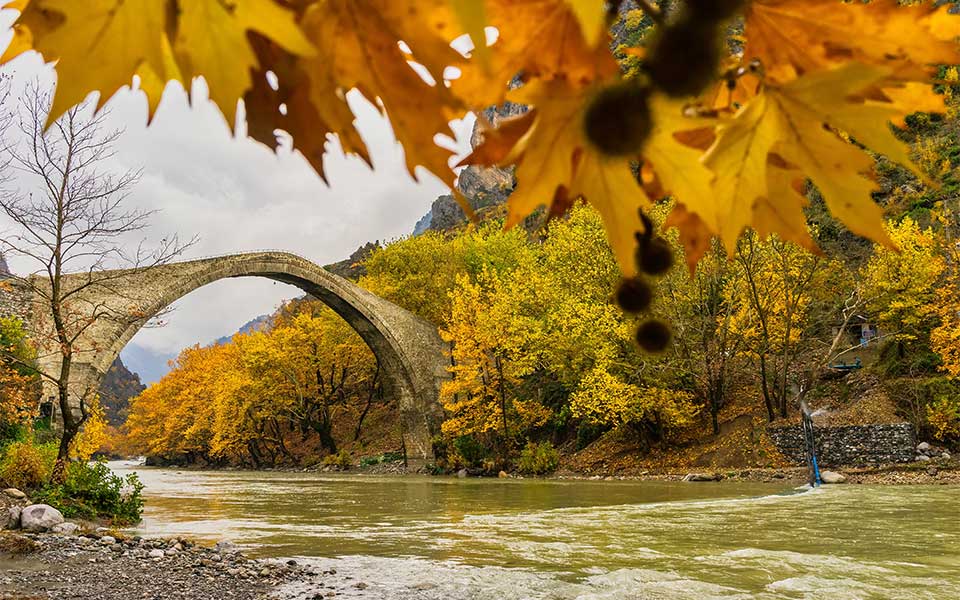We’ve said it said it once, we’ll say it a hundred times: there is no bad time to visit Greece. But if you’re looking to immerse yourself in the country’s rich historical and natural wonders, without the madding crowds and scorching heat of summer, the month of October may be just the ticket.
One of the many great things about October travel in Greece is the pleasantly warm climate, sunshine and clear skies, creating the ideal conditions to be out and about in Mother Nature. The seas are still plenty warm enough for swimming and water activities, too, and the beaches are blissfully uncrowded. October is also a prime time for nature enthusiasts. The landscapes are awash with vibrant autumnal hues as the foliage changes, making it a photographer’s dream.
An added bonus is that autumn marks the harvest season in Greece, giving visitors the opportunity to savor some of the freshest and most flavorful local produce. At this time year, you’ll find tables overflowing with beans – both fresh and dried, perfect for cooking traditional lathera (oil-based dishes) and soups.
If that wasn’t enough, October also hosts numerous cultural festivals and events across the country, showcasing some of Greece’s most enduring traditions, as well as the famous “Ohi Day” celebrations, held nationwide on the 28th.
As ever, these “best of” lists are highly subjective, but we hope the following will provide you with some inspiration for your next autumn escape in Greece.
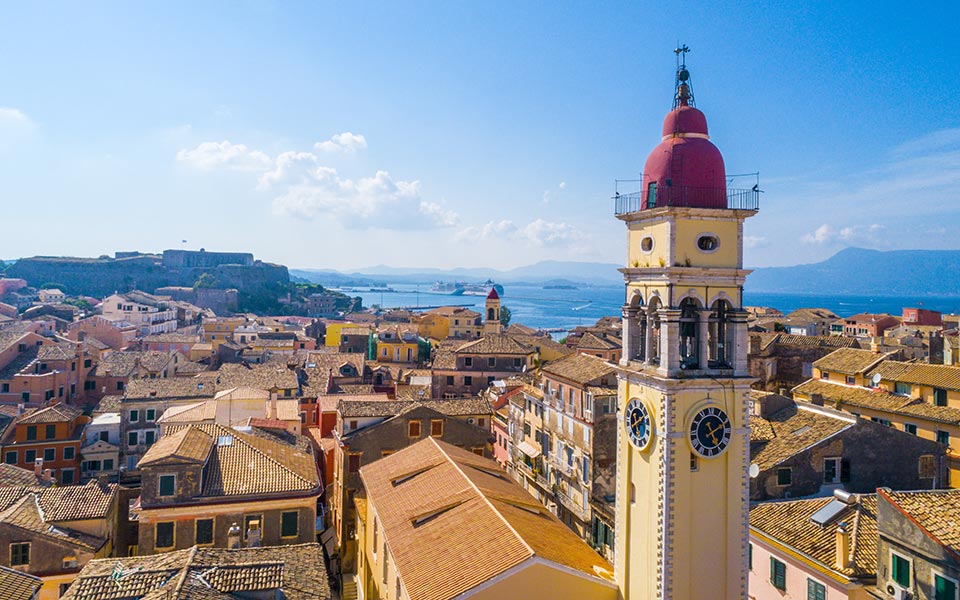
© Shutterstock
Corfu
Blessed with rich cultural heritage, stunning natural beauty, and lively festivals, Corfu ticks all the right boxes. There’s a reason why this Ionian island remains one of Greece’s most popular tourist destinations. But if you’re looking to beat the summer crowds, October is one the best months to enjoy long, leisurely strolls, the local cuisine, and even the beaches, as the weather still allows for swimming and sunbathing.
The Old Town, designated as a UNESCO World Heritage Site in 2007, is like a walk-in museum, showcasing architectural influences from the periods of Venetian and British rule. October is also ideal for a visit to Mon Repos and its lush gardens, the summer palace of the former Greek royal family. The 26-hectare estate, located just outside of the main town, is home to over 2,000 species of plants, flowers, and centuries old trees.
Now in its second year, Corfu’s International Festival runs from June to November, and features a multitude of events, from exhibitions and concerts to theatrical and dance performances. The festival utilizes many different venues in Corfu, from the Old Fortress and various churches to museums and squares in the Old Town. Check out the Festival’s program of events for October here.
For more travel tips on what to see and do in Corfu in the fall, click here.
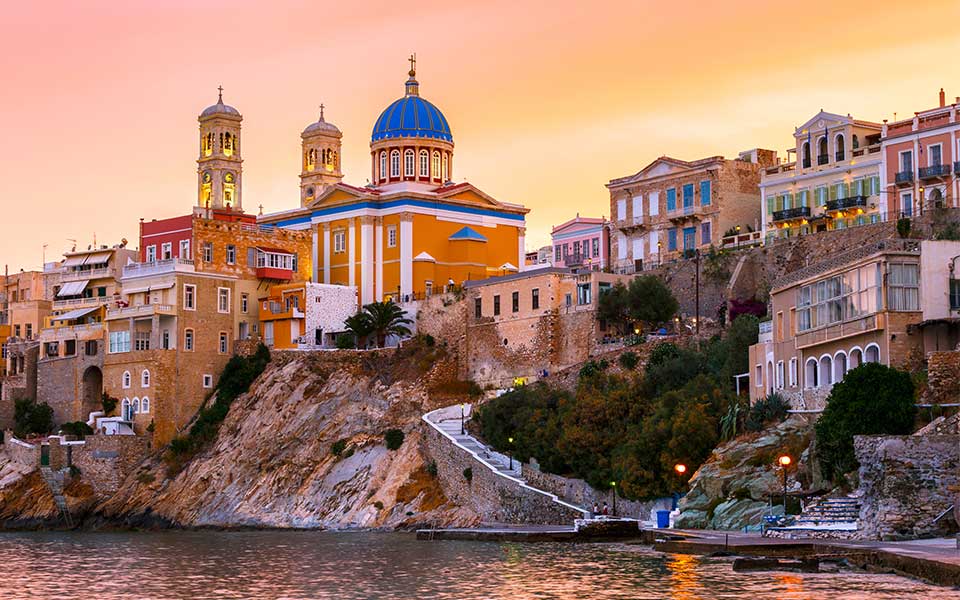
© Shutterstock
Syros
It’s fair to say that the island of Syros surprises most visitors. While its main town, Ermoupolis, is the capital of the Cyclades, it doesn’t look like your stereotypical Cycladic town. In fact, the whole island carries a different vibe; the way of life here is different, less dependent on tourism.
Popular in the summertime, your visit here in October will undoubtedly inspire less time at the beach, and more time wandering the stone paved streets admiring the impressive architecture. Stately 19th century neoclassical mansions, the colors of bird’s eggs – pale pinks, blues, and greens – line the seafront, giving the island an air of eclectic grandeur.
In October, the mild weather allows you to stroll the streets for hours, discovering the alleys, the grand mansions in the Vaporia neighborhood, and the large, beautiful churches. For an excursion, take a cab to the medieval settlement of Ano Syros (or Apano Chora – meaning upper village). As opposed to many other islands, Ermoupolis is a busy town year-round, so there are plenty of things to do.
The island, only two hours from Athens by high-speed ferry, is also home to some amazing cuisine, including local cheeses and sausages, and its famous loukoumia (sweets).
Click here for our guide to Syros’ industrial past.

© Shutterstock
Hydra
Hugely popular in the summertime, the “Grand Lady” of the Argosaronic Gulf, located a mere stone’s throw from Athens, takes on a more ambient character in the month of October. The bustling summer crowds have dispersed, allowing visitors to relish the island’s famously bohemian atmosphere.
Hydra is considered by many to be the island of art in Greece; it boasts several exhibition spaces and has a fanatical following among artists and musicians, many of whom are regular visitors, including David Gilmour of Pink Floyd fame, and his novelist wife, Polly Samson.
The pleasantly warm days and cooler nights in October enable visitors to savor the local cuisine in cozy tavernas, and engage in unhurried conversations with the friendly locals, especially in the coastal hamlets of Kamini and Vlychos. The temperature is perfect for outdoor exploration, whether it’s wandering through the island’s car-free cobblestone streets or hiking along its rugged coastline.
It’s also a good time to delve into the island’s rich history, evident in its well-preserved architecture and museums, including the Merchant Marine Academy and the Hydra Historical Archive Museum, located on the right side of the main town when looking out to sea.
October also brings a burst of vibrant colors to Hydra. The island’s lush landscapes transition into a kaleidoscope of reds, oranges, and yellows as leaves change, creating a stunning backdrop.
For more travel tips on Hydra, click here.
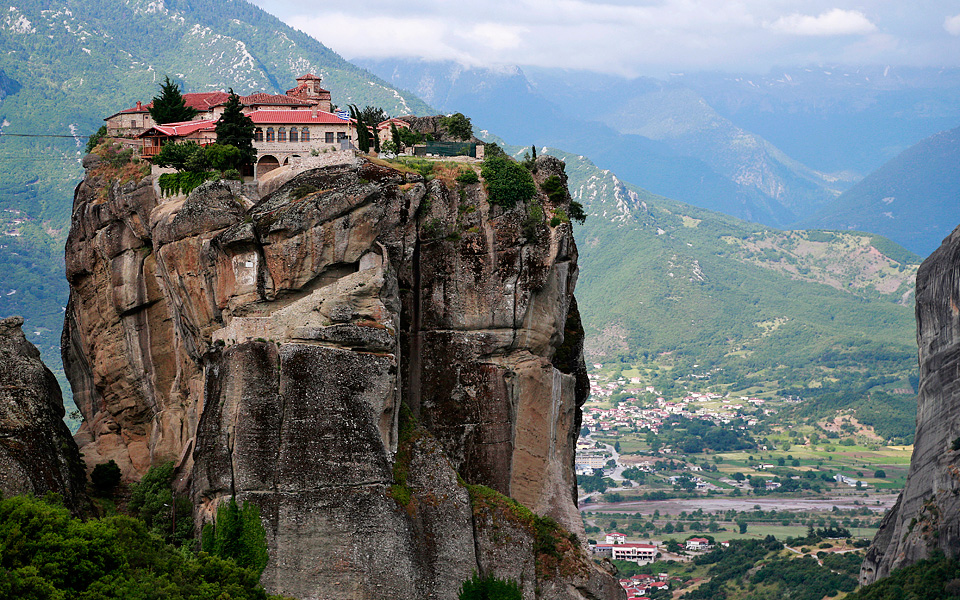
© AP
Meteora
Famed for its towering rocks topped by age-old monasteries, Meteora in northwest Thessaly is the quintessential “bucket-list destination.” Designated a UNESCO World Heritage Site in 1988, the monastic complex is one of the largest in the Eastern Orthodox world, second in importance only to Mount Athos.
Of the total of 24 monasteries that once formed this 1000-year-old community, 6 are still in operation and open to the public. Visiting them is to step into a world unto itself with wondrous examples of religious art on display in the churches and museums.
While many visit in the summer, the baking heat and large crowds can detract from the experience. The fall and winter, however, lend themselves to taking in the true majesty of the place. October’s milder temperatures provide the ideal conditions for hiking, rock climbing, and taking in the stunning scenery.
During the fall, the lush forests that surround Meteora’s dramatic rock formations and “hanging” monasteries transform into a symphony of autumn colors, with vibrant reds, oranges, and yellows creating a breathtaking backdrop. As such, Meteora in October is a paradise for budding photographers; the soft, diffused light and the changing colors of the landscape serve to create captivating scenes.
For adrenaline junkies, check out our guide to rock climbing in Meteora here.
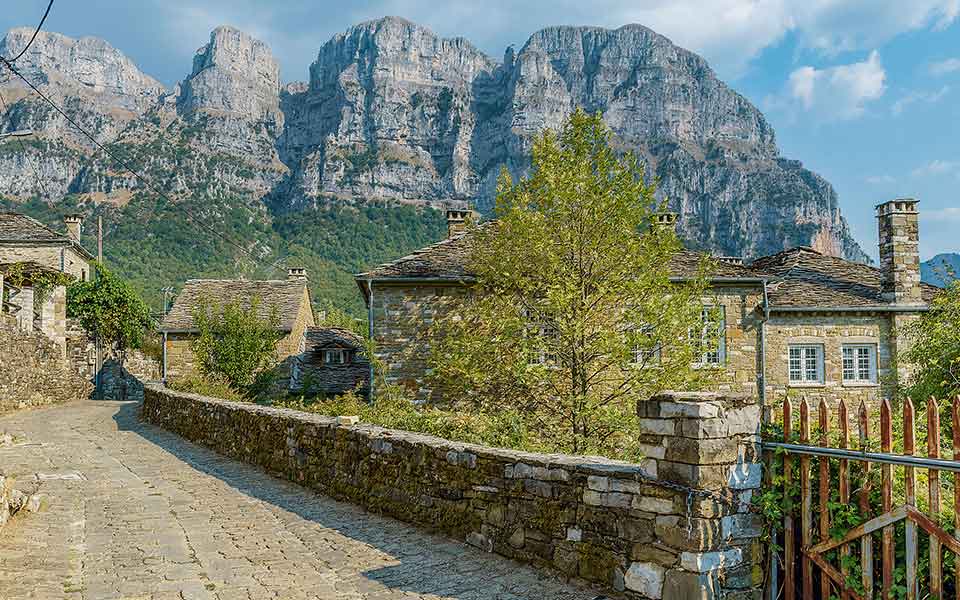
© Shutterstock
Zagorochoria
The Zagori region in northwest Greece has it all: a rich natural environment, renowned for the rugged peaks of Mount Tymfi, its numerous rivers like the Voidomatis River, beautiful gorges like the Vikos Gorge, thick forests, and impressive rock formations.
The region is also famed for its traditional architecture, recently inscribed in the category of Cultural Landscapes on UNESCO’s World Heritage list. Some 46 villages, known as the “Zagorochoria,” where the houses are entirely stone-built, and around 100 stone bridges, offer genuine lessons in architecture. All the buildings here are made of pieces of stone skilfully chiseled into place, usually without mortar, while the roofs are layered with plates of slate.
Megalo Papigo, Aristi, Monodendri are just some of the more touristy villages in the region, while Dilofo, Koukouli and Kapesovo preserve a more genuine charm.
The region boasts an exquisite cuisine, too, one that is based on the shrewd home economics developed by past generations with the use of natural ingredients and local production. Especially good are the pies, made with a variety of fillings, as well as exceptional local meats and cheeses.
For more on the enchanting Zagorochoria, click here.
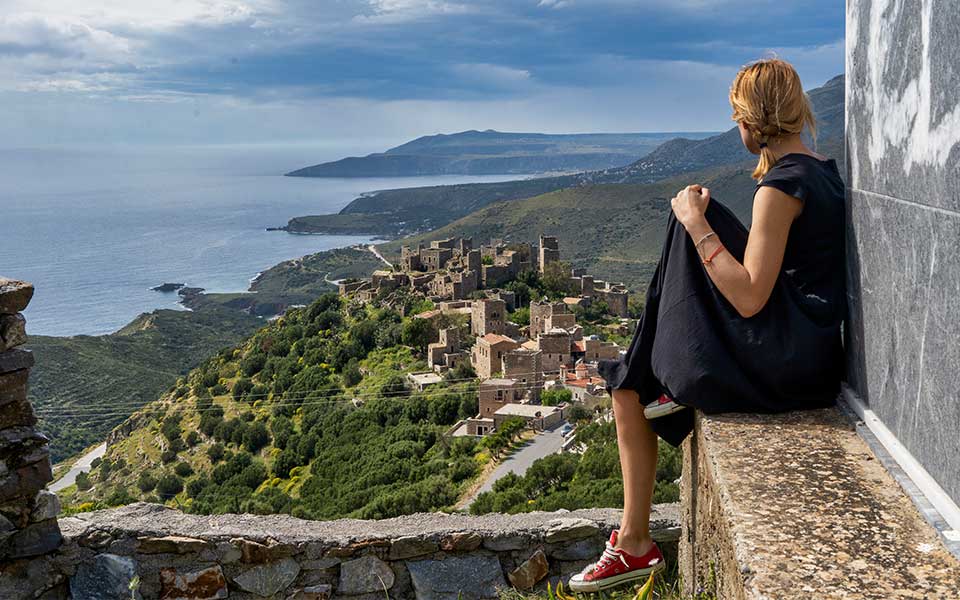
© Perikles Merakos
Mani Peninsula
Tower houses, rocky terrain washed by the sea, serene villages, and flags waving as if every day was a national holiday… This is Mani, the middle peninsula of the southern Peloponnese, a place where Greek flags flutter alongside local ones that read “Tan i epi tas” (“With it or on it”) – the legendary farewell phrase uttered by ancient Spartan women to departing warriors as they handed them their shields. The modern day inhabitants of this most rugged region of mainland Greece consider themselves to be the descendants of the ancient Spartans.
Barren and covered in brushwood, Mani is blazing hot in the summer, but even in the cooler temperatures of October, it is not the easiest destination. Be warned. You’ll need to do plenty of driving and walking, but the rewards are more than worth it. Here you’ll discover a land that is both proud and wild.
The peninsula is dotted with idyllic little harbors, such as Porto Kayio, the southernmost natural port of mainland Greece, and Limeni, the perfect blend of stone, turquoise waters and colorful caiques. If you can, stop here at sunset. Family-friendly Areopoli – “City of Ares” – with it charming stone houses and cobblestone alleyways, is one of the prettiest in Greece.
The abandoned settlement of Vatheia offers some of the best examples of the region’s famous tower houses (“pyrgi”), some reaching 20m in height. Built to control the area and repel hostile attacks from rival clans, the construction of towers intensified in the decades leading up to the Greek Revolution of 1821.
Click here for our guide to this most enigmatic region.
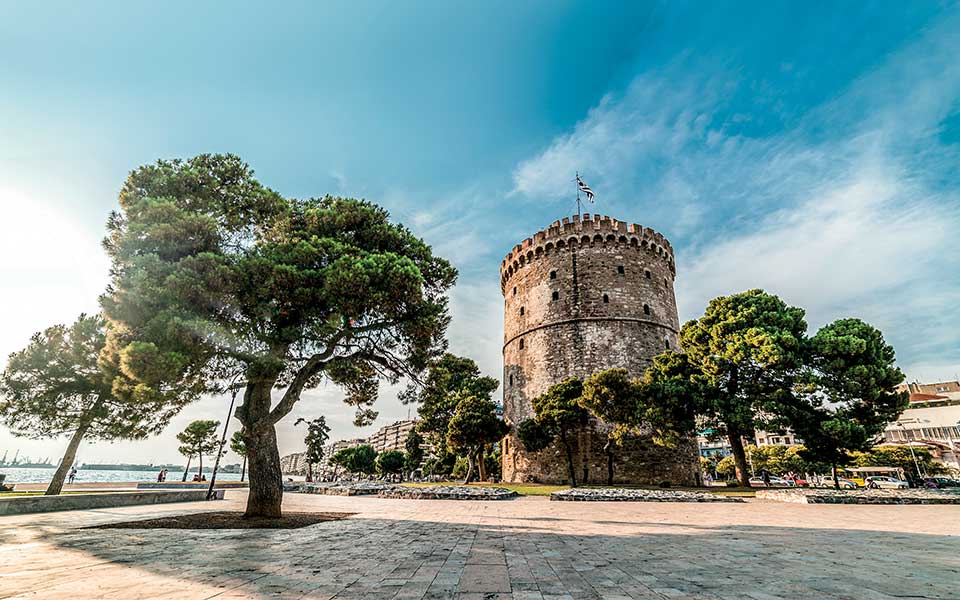
© Shutterstock
Thessaloniki
Famed for its burgeoning culinary scene, Thessaloniki, Greece’s “co-capital,” is fast building a reputation as one of Europe’s most exciting and dynamic city break destinations.
Thessaloniki is both ancient and modern, Eastern and Western, youthful and old-fashioned, sparkling and run-down, sleepy and restless, and full of creative energy that spawns new ideas. It only takes a long walk from its waterfront up to the picturesque district of Ano Poli, the oldest part of the city, to discover just how much the city has to offer. Here, you’ll encounter Roman-era monuments, Byzantine churches, beautifully restored Eclectic-style buildings, little neighborhood shops, and shopping arcades that time seems to have forgotten, as well as shiny new coffee shops and luxury boutique hotels. There is something for everyone here.
As the nights draw in, October is a fabulous time to visit Thessaloniki, enabling visitors to enjoy crowd-free walks around the city and explore its many museums, restaurants, and historical sites.
For our guide to Thessaloniki’s most famous landmarks, click here.
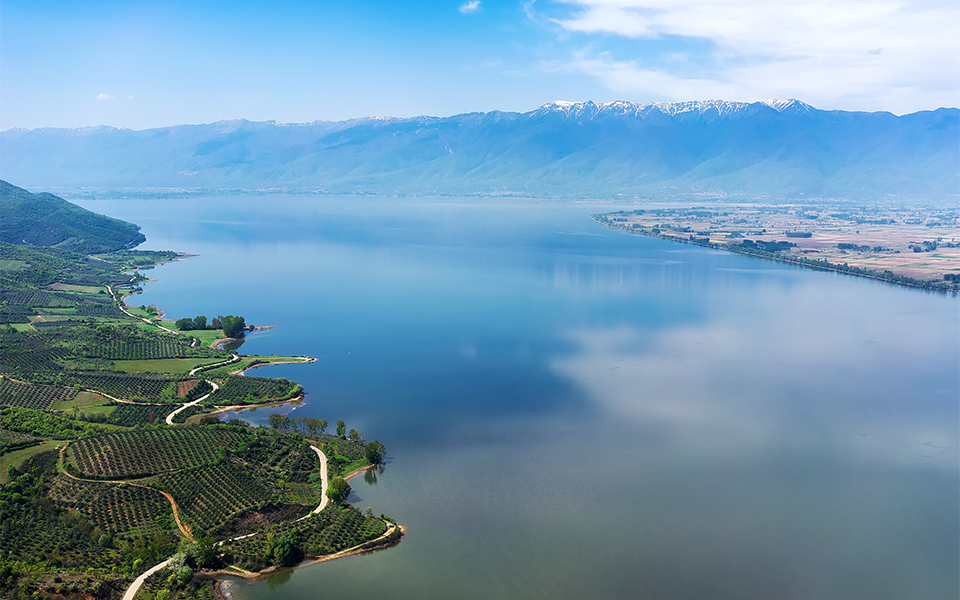
© Shutterstock
Kerkini Lake
Lake Kerkini, just south of the Greek-Bulgarian border, was created in 1932 as an artificial reservoir following the construction of a dam on the Strymon River in the area of the village of Lithotopos, Central Macedonia. Today the lake, and in particular its northern wetlands, has developed into a favorite spot for both migratory and non-migratory birds.
Birdwatchers from abroad visit the area for its protected wetlands and the bird species they attract, including great white pelicans, fish eagles and great black cormorants. The month of October is an especially busy time at the lake, as migratory species fly south for the winter.
In addition to its avian population, Lake Kerkini also attracts many fish species, primarily common carp and wels catfish. Wolves, jackals, hares and wild boar also roam the area. Boat rides around the lake, usually requiring about 90 minutes, are the best way of becoming acquainted with the lake.
The surrounding region offers a wealth of activities for outdoor enthusiasts, including hiking, cycling, and horse riding, and the nearby town of Serres, noted for its Archaeological Museum and pedestrianized shopping strip, is well worth a visit.
Click here for our road trip guide to Lake Kerkini.
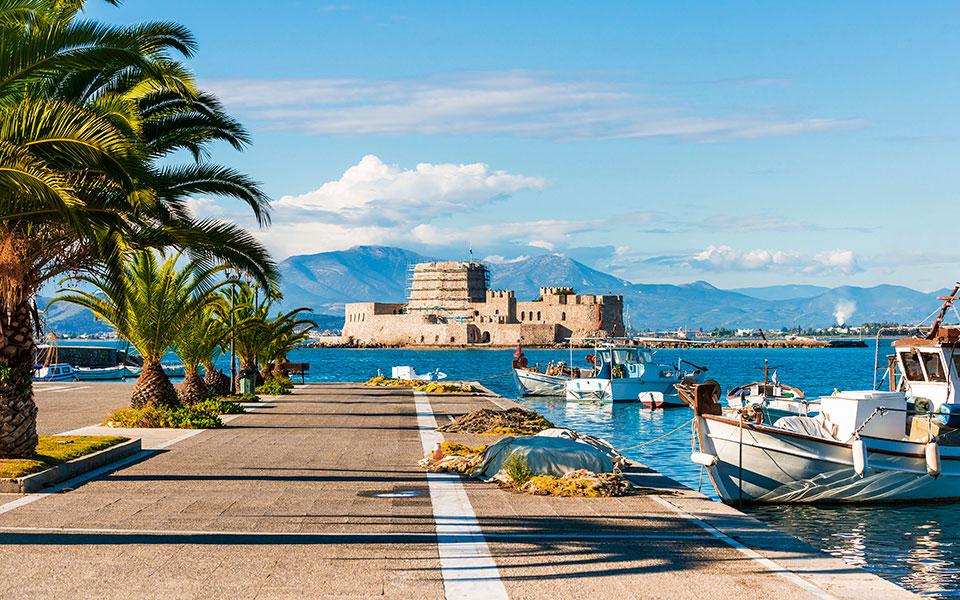
© Shutterstock
Nafplio
Located on the eastern coast of the Peloponnese, Nafplio has it all – charming restaurants and boutique hotels, stunning architecture in the old town, and the Venetian fortress of Palamidi towering high above the picturesque harbor.
Bustling in the summer months, we think that Nafplio is best enjoyed in the fall, the perfect place for a romantic getaway. The old town, with its cobbled streets and narrow alleyways, boasts some excellent cafes, restaurants and tavernas, not to mention its famous ice cream/gelato shops (get at least one gelato from Antica Gelateria di Roma).
If you’re physically up to it, climb the 853 steps – not 999, as is frequently said – up to Palamidi for the most amazing views of the Argolic Gulf (not for the faint hearted in July and August). Otherwise, opt for a relaxing and pleasant boat ride to Bourtzi castle, out in the middle of the harbor.
Nafplio is pedestrianized but may also be enjoyed by bicycle, bicycle-taxis, even little train rides. It is worth visiting Syntagma Square and the first Greek Parliament building, locally known as the Vouleutiko, the old mosque, and the interesting archaeological museum, housed in the Venetian arsenal.
For insider tips on what to see and do in Nafplio, click here.
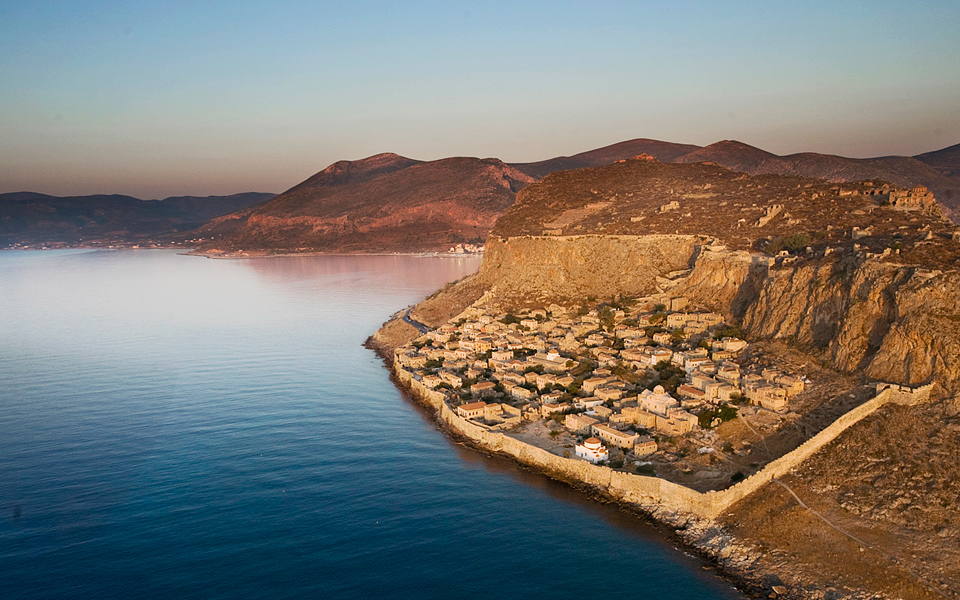
© Perikles Merakos
Monemvasia
An easy trip from Athens down the Peloponnese brings you to the beautifully preserved fortified town of Monemvasia, a place where time appears to have stopped.
Perched on a rock that became detached from the mainland following an earthquake in 375 AD, Monemvasia is reached by crossing a short bridge. Cars are left at the main gateway and visitors proceed on foot. Instructions for exploring the town are not necessary. Just stroll through any alley you see, and keep a look out for terraces with sensational views of the Myrtoan Sea below.
As a natural fortress, it was inhabited and soon became a strategic fortress claimed the Byzantines, Franks, Venetians and Ottomans. Neither museum-like nor artificially fabricated, Monemvasia is Europe’s only castle that has never ceased being inhabited, and 15 people are still permanent residents behind its limestone walls.
Monemvasia is a popular romantic destination for couples year round, but, like everywhere else in Greece, it’s especially difficult to find accommodation during the high summer season. As such, October is an ideal time to wander its cobbled streets, exploring medieval churches and sampling the local Malvasia wine (mentioned by Shakespeare in “Richard III”) at one of its bars or tavernas.
Check out our guide to Monemvasia here.

